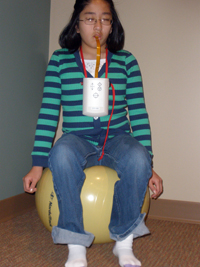 |
Stephanie Rehbein, 12, practices physical therapy exercises while using the Brain Port, a device designed to correct balance and prevent falls in those with balance disorders. UNMC’s Munroe-Meyer Institute is the first to study potential benefits of Brainport for children. |
The tipoff that the Omaha sixth-grader is not is a remote-like device that hangs around her neck. What looks like a thick piece of rust-colored Scotch tape runs from the device into Rehbein’s mouth like a tongue depressor.
With this machine, called the BrainPort, Rehbein hopes to rewire her brain.
Rare defect leads to imbalance
Born with Goldenhar syndrome — a rare congenital defect characterized by incomplete development of the ear among other facial features — Rehbein is deaf in one ear and has only 50 percent of her hearing in the other. The genetic disorder affects her vestibular or balance function and she has frequent dizzy spells.
It causes difficulties not only when Rehbein hikes at Camp Luther in Schuyler, Neb., but also when she lines up for lunch at school and someone bumps into her. There is concern she will fall more frequently next year when she hits the crowded hallways of junior high school.
Max Kurz, Ph.D., director of biomechanics in the motion analysis lab at MMI, along with his team of pediatric physical therapists Wayne Stuberg, Ph.D., Reggie Harbourne and Brad Corr hope to prevent that with the help of the BrainPort.
How the BrainPort works
The BrainPort uses a sensor placed on the tongue to detect and report any deviance from upright posture. For example, if one leans to the right, the stimulus tingles the tongue on the right side.
Such sensory information can be used as a replacement to a damaged vestibular system and correct balance and prevent falls, Dr. Kurz said.
“The brain is a remarkable system capable of rewiring itself,” he said.
“By providing sensory information using the BrainPort, children can learn to rewire other sensory receptors for stable balance or amplify the available vestibular sensory information that has not been lost.”
|
|
Rehbein, along with four other children with vestibular disorders, recently completed a variety of standing and walking studies to test gait and posture.
Eight weeks later, she will return to MMI for more. Meanwhile, she practices physical therapy exercises with the BrainPort at home twice a day for 20 minutes. Corr checks on her weekly to ensure progress.
BrainPort shows promise
A recent study showed adults with balance disorders improved their balance after using the BrainPort, Dr. Kurz said.
|
The long-term goal is for children to only use the device as a therapy tool and not on a daily basis once the brain is “rewired.”
“We hope these children can also improve their social acceptance and increase their participation in peer-equivalent activities such as riding a bike and playing sports along with having a reduced fear of falls,” Dr. Kurz said.